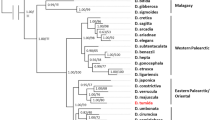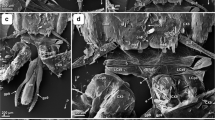Abstract
Litosaccus n. g. is erected for Paralecithobotrys brisbanensis Martin, 1974 n. comb. for which an amended description is given. The new genus is morphologically similar to the haploporine Lecithobotrys Looss, 1902 but with a more elongate and cylindrical body; an infundibuliform oral sucker; a thin-walled hermaphroditic sac; a shallow genital atrium; and unequal, cylindrical and elongated caeca. It also resembles Pseudolecithobotrys Blasco-Costa, Gibson, Balbuena, Raga & Kostadinova, 2009, but the only member of that genus has a hermaphroditic sac that is twice the length of the ventral sucker, a hermaphroditic duct with intensely-staining cuboidal cells, an elongate testis, and single or paired caeca. A Bayesian inference analysis of partial 28S rDNA sequences of L. brisbanensis and 24 other haploporoids revealed that L. brisbanensis grouped with other haploporines and placed Intromugil Overstreet & Curran, 2005 in a clade with the chalcinotrematine Saccocoelioides Szidat, 1954 rather than the other seven tested waretrematine species. This analysis represents the first phylogenetic study of the Haploporidae Nicoll, 1914 that incorporates a haploporine from outside of the Mediterranean Sea.


Similar content being viewed by others
References
Besprozvannykh, V. V., Atopkin, D. M., Ermolenko, A. V., & Nikitenko, A. (2014). Restoration of the genus Parasaccocoelium Zhukov, 1971 (Digenea: Haploporidae) and a description of two new species from mugilid fish in the Far East of Russia. Journal of Helminthology (In press).
Blasco-Costa, I., Balbuena, J. A., Kostadinova, A., & Olson, P. D. (2009a). Interrelationships of the Haploporinae (Digenea: Haploporidae): a molecular test of the taxonomic framework based on morphology. Parasitology International, 58, 265–269.
Blasco-Costa, I., Gibson, D. I., Balbuena, J. A., Raga, J. A., & Kostadinova, A. (2009b). A revision of the Haploporinae Nicoll, 1914 (Digenea: Haploporidae) from mullets (Mugilidae): Haploporus Looss, 1902 and Lecithobotrys Looss, 1902. Systematic Parasitology, 73, 107–133.
Bray, R. A., Cribb, T. H., Waeschenbach, A., & Littlewood, D. T. J. (2014). Molecular evidence that the genus Cadenatella Dollfus, 1946 (Digenea; Plagiorchiida) belongs in the superfamily Haploporoidea Nicoll, 1914. Systematic Parasitology, 89, 15–21.
Bray, R. A., Waeschenbach, A., Cribb, T. H., Weedall, G. D., Dyal, P., & Littlewood, D. T. J. (2009). The phylogeny of the Lepocreadioidea (Platyhelminthes: Digenea) inferred from nuclear and mitochondrial genes: implications for their systematics and evolution. Acta Parasitologica, 54, 310–329.
Cribb, T. H., & Bray, R. A. (2010). Gut wash, body soak, blender and heat-fixation: approaches to effective collection, fixation and preservation of trematodes of fishes. Systematic Parasitology, 76, 1–7.
Curran, S. S., Tkach, V. V., & Overstreet, R. M. (2006). A review of Polylekithum Arnold, 1934 and its familial affinities using morphological and molecular data, with description of Polylekithum catahoulensis sp. nov. Acta Parasitologica, 51, 238–248.
Darriba, D., Taboada, G. L., Doallo, R., & Posada, D. (2012). jModelTest 2: more models, new heuristics and parallel computing. Nature Methods, 9, 772.
Hall, T. A. (1999). BioEdit: a user-friendly biological sequence alignment editor and analysis program for Windows 95/98/NT. Nucleic Acids Research, 41, 95–98.
Huelsenbeck, J. P., & Ronquist, F. (2001). MRBAYES: Bayesian inference of phylogeny. Bioinformatics, 17, 754–755.
Huelsenbeck, J. P., Ronquist, F., Nielsen, R., & Bollback, J. P. (2001). Bayesian inference of phylogeny and its impact on evolutionary biology. Science, 294, 2310–2314.
Katoh, K., Kuma, K.-I., Toh, H., & Miyata, T. (2005). MAFFT version 5: improvement in accuracy of multiple sequence alignment. Nucleic Acids Research, 33, 511–518.
Lester, R. J. G., Rawlinson, S. E., & Weaver, L. C. (2009). Movement of sea mullet Mugil cephalus as indicated by a parasite. Fisheries Research, 96, 129–132.
Martin, W. E. (1973). A new genus and species of haploporid trematode (Haploporidae: Trematoda) from Australian mullet. Bulletin of the Southern California Academy of Science, 72, 166–168.
Martin, W. E. (1974). Paralecithobotrys brisbanensis sp. n. from Australian mullet (Trematoda: Haploporidae). Proceedings of the Helminthological Society of Washington, 41, 16–18.
Olson, P. D., Cribb, T. H., Tkach, V. V., Bray, R. A., & Littlewood, D. T. J. (2003). Phylogeny and classification of the Digenea (Platyhelminthes: Trematoda). International Journal for Parasitology, 33, 733–755.
Overstreet, R. M., & Curran, S. S. (2005). Family Haploporidae Nicoll, 1914. In: Jones, A., Bray, R. A. & Gibson, D. I. (Eds) Keys to the Trematoda. Volume 2. Wallingford, UK: CAB International, pp. 129–167.
Pulis, E. E., Fayton, T. J., Curran, S. S., & Overstreet, R. M. (2013). A new species of Intromugil (Digenea: Haploporidae) and redescription of Intromugil mugilicolus. Journal of Parasitology, 99, 501–508.
Pulis, E. E., & Overstreet, R. M. (2013). Review of haploporid (Trematoda) genera with ornate muscularisation in the region of the oral sucker, including four new species and a new genus. Systematic Parasitology, 84, 167–191.
Wu, M., Chatterji, S., & Eisen, J. A. (2012). Accounting for alignment uncertainty in phylogenomics. PLOS ONE, 7, e30288.
Acknowledgements
The authors are grateful to the following people for their contributions to the procurement of hosts, assistance in trying to locate type-material and providing accession numbers: Robert Adlard, Mal Bryant, Adam Fletcher, Daniel Geiger, Jeff Johnson, Jason Lally, Joel Martin, Patricia Pilitt, Gabor Racz, and Patricia Sadeghian. From the University of Southern Mississippi, we thank Jean Jovonovich Alvillar and Janet Wright for their assistance with DNA sequencing reactions. The material treated here is based on work supported by the National Science Foundation under grant no. 0529684, Ocean and Human Health Initiative grant no. NA08NOS4730322, and US Fish and Wildlife Service/Mississippi Department of Marine Resources MSCIAP MS.R.798 Award M10AF20151.
Author information
Authors and Affiliations
Corresponding author
Rights and permissions
About this article
Cite this article
Andres, M.J., Pulis, E.E., Cribb, T.H. et al. Erection of the haploporid genus Litosaccus n. g. and its phylogenetic relationship within the Haploporidae Nicoll, 1914. Syst Parasitol 89, 185–194 (2014). https://doi.org/10.1007/s11230-014-9521-4
Received:
Accepted:
Published:
Issue Date:
DOI: https://doi.org/10.1007/s11230-014-9521-4




